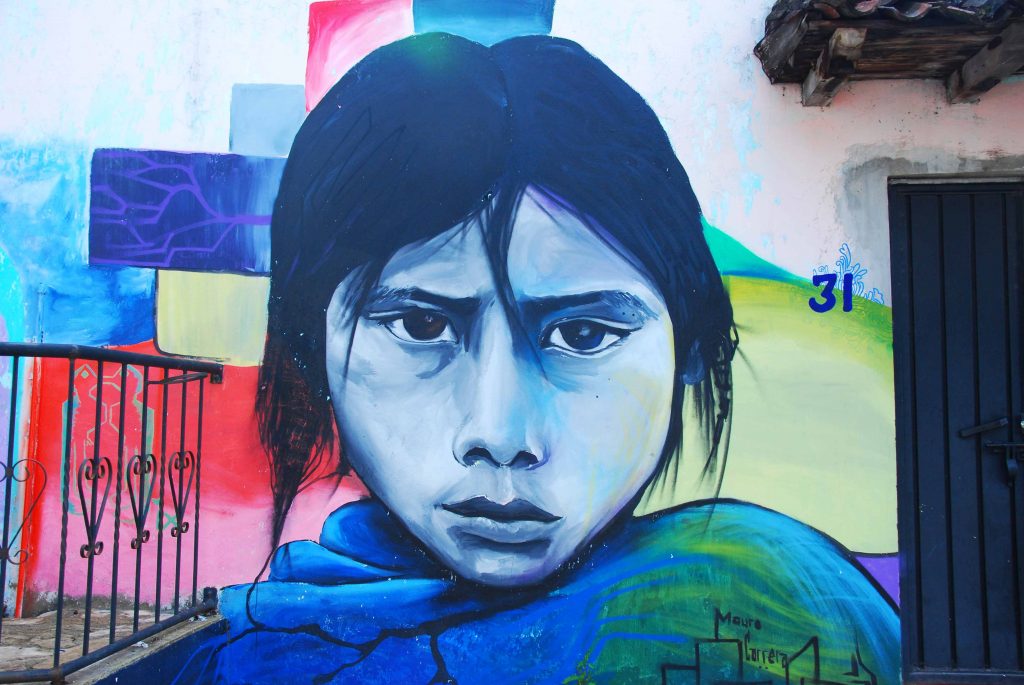Before I even pull the latch on the clunky metal door of my apartment I can hear the melody of “Raindrops are Falling on my Head” becoming increasingly louder. How the song relates to the massive bottled water truck that blasts it from its rusty speakers is beyond me. The tune floats in and out of my ears most of the day so much so that I barely notice it anymore.
I walk out from my apartment on Diego Dugelay and into the warmth of the sun on the sidewalk. An older Mexican man walks past. His sunbeaten face, which matches his worn leather belt, is shaded by a pristine white cowboy hat that rests atop his head. He is pushing a bright torquoise cart. A peek inside reveals a stack of grey tarp that is fraying at the ends and on top lies a bag of pink and yellow ice cream cones.
Walking past the corner I acknowledge the cracking wooden sign for “Electrovodoo,” which always leaves me wondering what their business could be. Hostel? Disco? Haitian witch doctor?
Continuing down the street, the buildings transition from peach colored walls with red trim to pale mint green. Certain spots have chipped away revealing a mosaic of orange, blue and white previous layers. An archive of the buildings’ past lives.
Graffiti scrawled across the face of the building, in the form of “Fany, te amo” haphazardly confesses young love.
The uneven cobblestones of Real Guadalupe catch me off guard and my foot plops down into a puddle. Grey gutter water soaks into my shoe and leaves a streak on my calf that dries almost immediately.
I pass a store that sells everything in the form of cereals, spices and candy, but not much in between. The bitter and musty smell of dried chilis follows my nostrils as I walk by.
The daylight is quickly fading and I can barely make out the thin grey outline of the Los Altos mountain range in the distance as it fades into the hazy dusk sky. On queue, the streetlights blink on, announcing the start of the night.
As I pass different groups I catch snipets of conversation in English, Spanish and the local indigenous language, Tsotsil.
“Chiclet!” I turn around to find a barefoot young boy carrying a tray of gum, chocolates and cigarettes. I reluctantly decline and turn to go, only to be intercepted by his mother. She has a rainbow of shawls spilling over her arm and thick woven panchos over the other. Her eyes are large and dark brown and seem to be sinking into her face. A defined scar cuts across her upper lip. A second son pops out from behind her, his arms full of small animals carved from wood- yellow jaguars with black spots and orange horses with manes of red yarn.
“Compreme un pan,” buy me a bread, they compromise after I’ve given my 10th “no, gracias.”
I hear a shrill cry followed by choked sobbing. Its only then that I realize the woman has a third child nestled against her back, strapped to her body by a violet shawl, a faded version of the ones she’s selling.
As we get closer to the Zocolo, plaza, I can hear the carnival music that emanates from the park every night. A white car zooms through a side street and a teenage boy hangs out the window, a cigarette in one hand, calling for his friends who stand on the corner.
We arrive at our destination, our favorite cafe that has two for one hot chocolate on Thursdays. We give the server our order and grab a table outside on the walkway, a beautiful spot, but it’s a gamble depending on how many sellers are out that night. Sure enough, just as we settle in, an elderly Mexican woman makes a beeline for our table. Her baby blue sweater contrasts the satin peach shirt with opal buttons underneath. She is wearing the traditional lana skirt, a thick black wool that wraps like a puffy blanket down to her ankles. It’s held up by a silver woven belt. Most women hand make these using wool from their own sheep, but we’ve heard they can sell for up to $800 in the market.
“Como te llamas,” my boyfriend asks, always the first to break the ice.
Most venders usually give us a curt reply, eager to continue selling. But this woman looks engaged.
“Maria,” she replies with a grin that reveals more than a couple missing teeth. She holds up a handful of woven bracelets. A mix of different patterns intertwine plum purples, sage greens, poppy yellows and curry oranges.
My boyfriend engages her in a short conversation before she turns to me and says something in heavily accented Spanish.
“No,” I shake my head, “No gracias.”
The woman and my boyfriend just blink at me.
“She asked you your name,” Jules says, “not to buy something.”
Overcome with guilt for my knee jerk reaction, I give her my name in the friendliest tone possible.
“Maria,” she gracefully responds with a small bow of her head , “mucho gusto.”
One last nearly toothless grin and she waddles off down the street, showcasing her bracelets to the next group of travelers.
